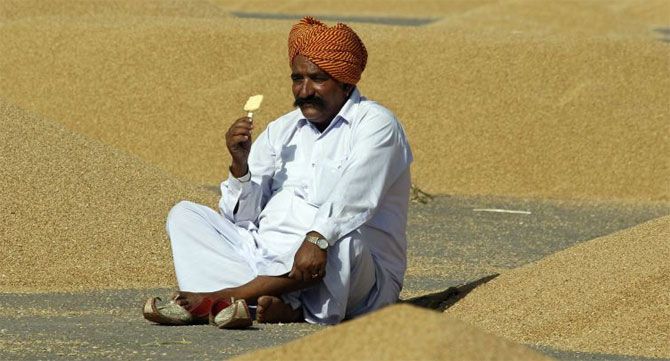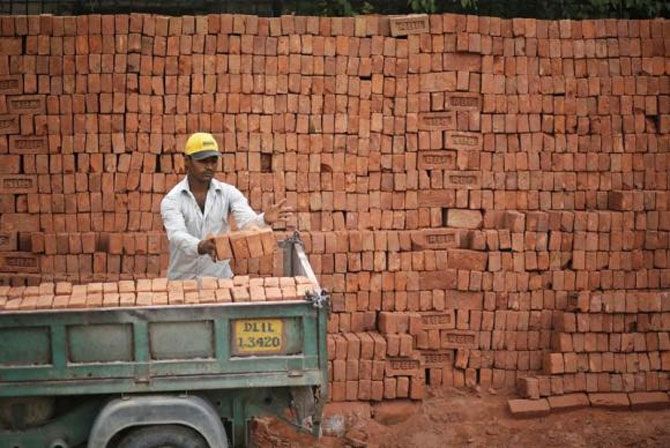Because of India's weak fiscal position, the plethora of debt-burdened infrastructure companies and the poor asset quality of public sector banks, economic growth in 2015-16 may be limited to about six per cent, say Shankar Acharya.

The new year has just begun. It’s a good time to take stock of the year past and try to discern some shapes in the mists ahead.
2014 global retrospect
Someone recently asked for my pick of the 10 most significant political economy developments and trends of 2014. Here they are, guided, mainly, by their likely resonance in the new year:
This was the year China decisively asserted its political and economic clout in Asia, pressing her claims aggressively in the South and East China seas (and air space), much to the discomfiture and apprehension of Vietnam, the Philippines, Japan and the United States, among others. Sino-Japanese relations remained tense through most of the year. India experienced her share of Chinese military pressure across the northern border (or the Line of Actual Control) during President Xi Jinping’s state visit in September.
The Chinese economy continued to slow, to perhaps seven per cent growth in 2014, well below the double-digit rates of 1980-2010. That is still an unprecedented pace of expansion for a $10-trillion economy, adding, each year, economic activity equivalent to a third of India’s entire economy.
The revolution in shale oil and gas production in America attained maturity, lifting the country’s self-sufficiency in oil to nearly 90 per cent and becoming a leading sector in the ongoing recovery in production and employment in the world’s largest single-country economy ($17 trillion).
The combination of a slowing China, surging United States oil production, stagnant Europe and Japan and the Organization of the Petroleum Exporting Countries’ determination to maintain output levels led to an astonishing crash in oil prices (Brent crude) from around $110 in June to below $60 by end-December. Together with sharp declines in other commodity prices, it rang in the end of the commodity “super-cycle” of the past eight or nine years, with major consequences for exporter (adverse) and importer (beneficial) nations.

The collapse in oil prices and mounting Western sanctions against Russia’s muscular policies in Ukraine led to a sharp decline in the value of the rouble from about 35 a dollar in July to 60 a dollar in late December, taking a substantial toll of the Russian economy, which is officially expected to contract by around five per cent in 2015.
The astonishing eruption of the Islamic State of Iraq and Levant (ISIL), with its brutal brand of Islamic jihadism, posed new threats to peace and stability in conflict-ridden West Asia and heightened the chances of terrorist attacks globally, including in South Asia.
The persistence of economic stagnation in European Union ($18 trillion) and unexpected recession in the Japanese economy ($5 trillion) hurt global growth and trade significantly.
The programme of prolonged and massive quantitative easing in the United States monetary policy tapered off, with clear prospects of a rise in interest rates sometime in the new year.
In the arena of climate change, the final quarter of the year saw both the United States-China bilateral agreement and the Lima conference “Call for Action”. Together, they effectively undercut any hopes for a serious international agreement to curtail carbon emissions to stay within a two-degree centigrade rise in atmospheric temperature. So the long-term prospects for serious damage to livelihood and lives from climate change increased appreciably.
Last but perhaps not least, the largest electorate in the world voted for a decisive change in government in India in May, giving the Bharatiya Janata Party (BJP) the first single-party majority in the lower house in 30 years, and the first ever for a non-Congress party. By the year’s end, the enormous, early hopes for change and reform in governance and economic policy had dimmed significantly, though not been extinguished.

2015: outlook from India
The prospects for India’s development and security will be influenced substantially by the trends and developments noted above. With the United States’ growth in 2015 expected at three per cent plus, China’s at sub-seven per cent, the European Union’s (overshadowed by the Greek crisis) at one per cent or less and Japan’s at 1.5 per cent (together, these four economies account for about two-thirds of world gross domestic product or GDP), global economic growth (at market exchange rates) is likely to remain subdued at around 2.5 per cent, with world trade expanding at an anaemic two-four per cent. Predicting international oil prices is a mug’s game.
The prevailing view expects prices to drop further before shrinkages of supply from higher-cost sources tighten the demand-supply equation and lead to a price recovery sometime in the latter half of 2015, perhaps to levels of $70 or $80 a barrel. The United States policy interest rates are expected to rise from their current floor in the course of the next few months, inducing some reversal of recent capital flows to emerging markets.
In sum, from India’s perspective, the prospects for 2015 are for subdued global growth and trade, soft commodity prices for most of the year, and substantial volatility in capital flows, remittances and exchange rates. Not a very supportive international economic environment, except for the weak commodity prices.
What about domestic economic policy? After a weak start (epitomised by the July Budget), the Modi government has undertaken a series of incremental policy initiatives to spur economic activity and improve macroeconomic and sectoral performance. Where legislative change has been involved, as in the case of the coal blocks auction, amendments to the unworkable 2013 land acquisition Act and raising the foreign investment limit in insurance, the government has run into intransigent opposition in the Rajya Sabha.
How much of this has been due to innate hostility from opposition parties and how much to a backlash against apparent governmental tolerance of communally tinged socio-religious initiatives (like “ghar wapsi”) by the Sangh Parivar is hard to say. Certainly, the latter set of initiatives (extending to education, art and culture) have distracted public debate and discourse from the government’s economic development agenda.
The government’s recourse to ordinances to overcome the Upper House block reflects an admirable “let’s get on with it” attitude. However, whether this approach will be viable or effective remains an open question and to that extent uncertainty could damp investor response.
Given the anaemic global economic environment, the obstacles to economic reform noted above, the government’s surprisingly weak fiscal position, the baneful legacy of bad economic laws and damaging court judgments, the plethora of debt-burdened infrastructure companies and the poor asset quality of public sector banks, economic growth in 2015-16 may be limited to about six per cent.
Consumer price inflation is likely to be of the same order. The external payments situation could come under some pressure from lower remittances from Gulf nations, slow export growth, a possible rebound in oil prices and a slowdown in foreign portfolio investment, especially when the United States policy interest rates increase.
This outlook is not a resounding vindication of “acche din”; but with continued improvement in macroeconomic and sectoral policies, economic performance in 2016-17 could see outcomes closer to really good days.
Shankar Acharya is honorary professor at ICRIER and former chief economic adviser to the government. These views are his own












 © 2025
© 2025